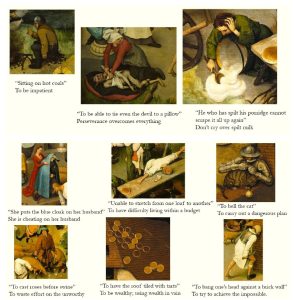Pieter Bruegel, Netherlandish Proverbs
The greatest Netherlandish painter of the mid-sixteenth century was Pieter Bruegel the Elder (c. 1528-1569). No matter how huge a slice of the world the artist depicted, human activities remain the dominant theme. Like many of his contemporaries, Bruegel traveled to Italy, where between 1551 and 1554 he went as far south as Sicily and was in Rome in 1553. Unlike other artists, however, Bruegel chose not to incorporate classical elements into his paintings. His Netherlandish Proverbs, depicts a Netherlandish village populated by a wide range of people, encompassing nobility, peasants, and clerics. By illustrating more than a hundred proverbs in this one painting, the artist indulged his Netherlandish audience’s obsession with proverbs, passion for detailed and clever imagery, and interest in human folly.[1]

Here are some of the 100+ proverbs illustrated in Bruegel’s work. Are any of the English counterparts familiar to you?

- Fred S. Kleiner, Gardner’s Art Through the Ages: The Western Perspective, vol. 2, 15th ed., (Boston: Cengage Learning, 2017), 571. ↵

